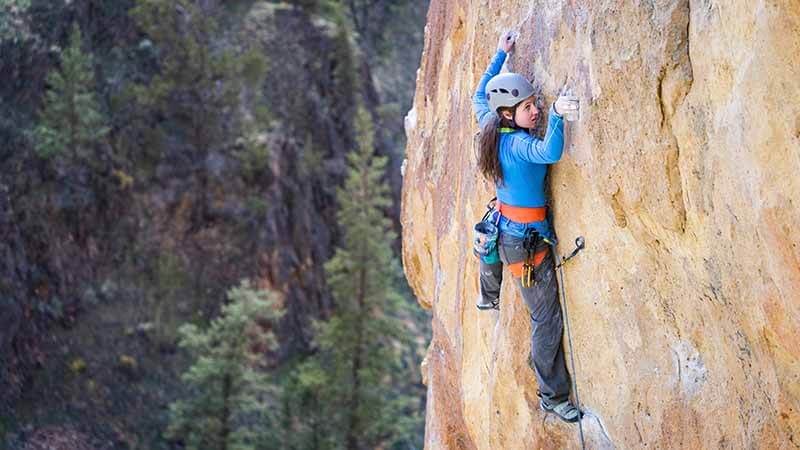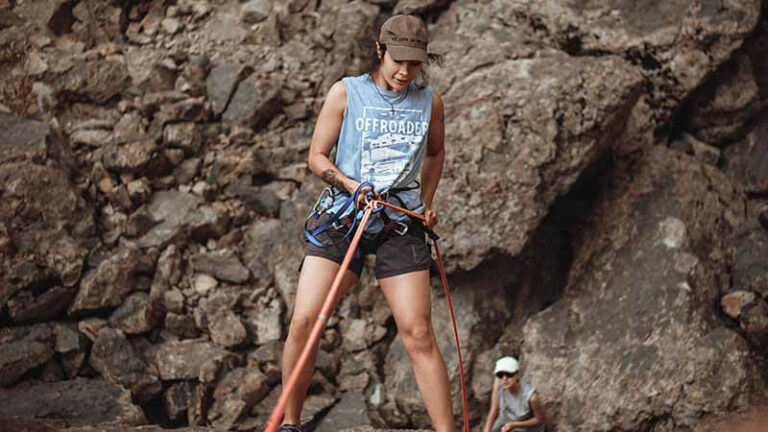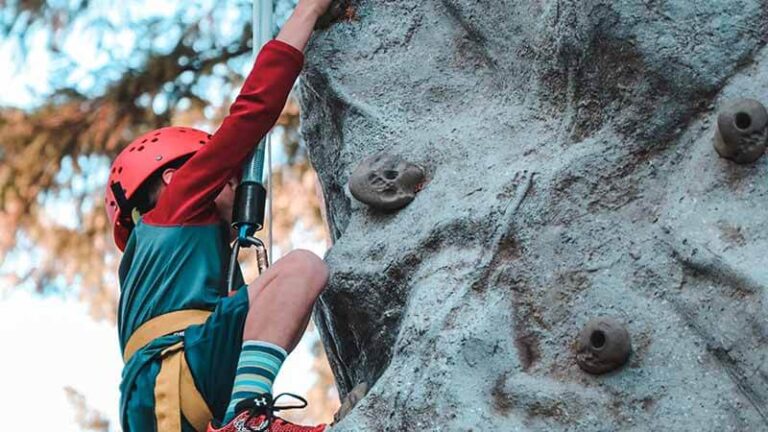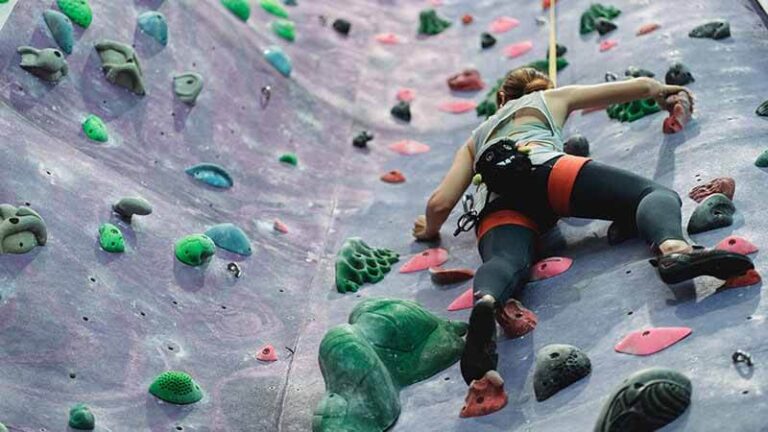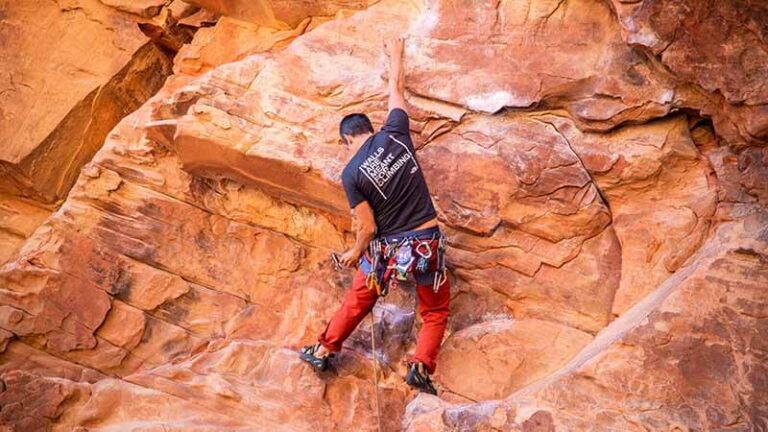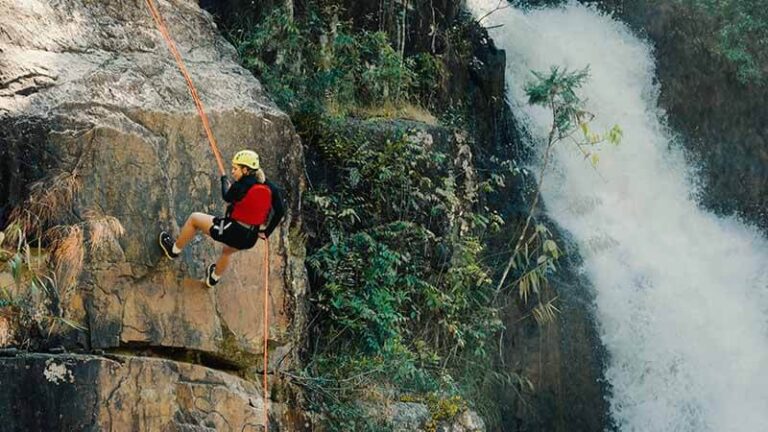What Makes Rock Climbing Fun?
Rock climbing is a sport in which participants use specialized equipment and skills to ascend steep or vertical rock formations. It can be done indoors or outdoors, on natural or manmade rock surfaces, and with or without a partner’s or rope’s assistance. Rock climbing’s purpose is to reach the top of a rock face, also known as a “route” or “problem,” by utilizing physical and mental power, balance, and agility. Rock climbing necessitates a combination of ability, technique, physical fitness, mental focus, and tenacity.
Why rock climbing is an enjoyable activity
For a multitude of reasons, rock climbing can be an extremely pleasurable and satisfying activity. For starters, it’s a fantastic way to push yourself physically and intellectually, pushing your limitations and overcoming hurdles. It also gives you a unique opportunity to interact with nature as you ascend huge rock faces and take in beautiful views. Furthermore, rock climbing can be a social activity, allowing you to meet new people, make new friends, and work together to achieve a common goal.
The main themes of this post will be what makes rock climbing enjoyable and why it is a fun hobby. We will specifically look at the physical and emotional obstacles of rock climbing, as well as the unique connection to nature and social aspects of the activity. We intend to present a broad overview of why so many people find rock climbing to be so exciting and gratifying by studying these various aspects of the sport.
Physical Challenge
How rock climbing is physically challenging
Climbing rocks is a physically difficult sport that calls for strength, endurance, and agility. Climbers drag themselves up the rock face with their arms, legs, and core muscles while maintaining balance and stability. The activity can also be physically demanding due to the variety of rocks used, which vary in texture, shape, and angle. Climbers may encounter overhangs, cracks, ledges, and other difficulties that require specialized tactics and strength to overcome, depending on the route.
Different types of physical challenges rock climbers face
Climbers confront a number of physical problems, which differ based on the sort of climbing done. Among the most prevalent physical challenges are:
- Endurance: Climbing for long periods of time can be physically tiring, necessitating climbers’ ability to retain strength and attention during the ascent.
- Strength: Climbing demands a lot of upper body strength, as well as core and lower body strength to stay balanced and stable.
- Climbers frequently rely on their finger strength to grab the granite surface and pull themselves up.
- Flexibility: To reach and maintain diverse positions on the rock surface, rock climbing requires a high level of flexibility.
- Footwork: Climbers must be able to efficiently use their feet to maintain balance and support their weight while they climb.
How the physical challenge contributes to the fun of rock climbing
One of the key reasons why rock climbing is such a fun hobby is the physical difficulty. Overcoming physical barriers and pushing oneself to the maximum can be extremely physically and mentally satisfying. Many climbers appreciate the sense of success that comes with reaching the summit of a difficult route or problem, and the physical challenge of the activity can aid in the development of confidence and self-esteem.
Furthermore, the physical challenge of rock climbing can provide a rush of adrenaline and excitement, making the sport even more appealing to those who enjoy a good challenge.
Mental Challenge
How rock climbing is mentally challenging
Rock climbing is not only a physically hard sport, but it is also a mentally demanding one. Climbers must utilize their concentration, problem-solving ability, and decision-making skills to climb the rock face and discover the best path to the top. Rock climbing’s mental challenge can be just as challenging as its physical challenge, requiring a great lot of mental fortitude and resilience.
Different types of mental challenges rock climbers face
Climbers confront a number of mental problems, which differ based on the sort of climbing done. Among the most frequent mental issues are:
- Worry and fear: Climbing is an inherently dangerous and risky activity, and climbers may suffer fear or worry as they ascend the rock face.
- Problem-solving: Climbers must be able to study the rock face and choose the best route to the summit, which frequently necessitates quick thinking and strategic planning.
- Concentration and attention: Climbers must maintain their focus and concentration during the ascent, as even a little gap in concentration might result in a fall.
- Mental exhaustion: Climbing for long periods of time can be mentally exhausting, requiring climbers to be mentally sharp and aware.
How the mental challenge contributes to the fun of rock climbing
Rock climbing’s mental difficulty is a key part of what makes the activity so fun. Overcoming fear and anxiety, problem-solving, and remaining mentally alert during the climb can be extremely rewarding, and can aid in the development of mental fortitude and resilience. Many climbers like the mental challenge of rock climbing because it forces them to push themselves physically and intellectually to the limit, and it can bring a sense of accomplishment and satisfaction that is difficult to obtain in other sports.
Furthermore, the mental challenge of rock climbing can aid in the development of important life skills such as perseverance, determination, and critical thinking, making it an excellent activity for people of all ages and backgrounds.
Connection to Nature
How rock climbing allows for a unique connection to nature
Rock climbing is a sport that provides a unique connection to nature because it often takes place in remote and scenic regions that are otherwise inaccessible. Climbers can immerse themselves in natural environs, experiencing the sights, sounds, and sensations of the outdoors in ways that other pursuits cannot. Rock climbing gives people a connection to nature that is difficult to imitate in other sports or pastimes.
Benefits of being immersed in nature while rock climbing
Being immersed in nature when rock climbing has various advantages. Among the most significant advantages are:
- Tension reduction: Spending time in nature has been proven to relieve tension and anxiety while also having a relaxing impact on the mind and body.
- Mental rejuvenation: Spending time in nature can help to recover mental energy and boost mood, giving you a much-needed reprieve from the rigors of everyday life.
- Climbing in natural settings can bring physical benefits such as enhanced cardiovascular health, increased strength and endurance, and improved balance and coordination.
- Awe and amazement: Climbing in natural areas can create a sense of awe and wonder, helping people to appreciate nature’s beauty and strength.
Different environments in which rock climbing can take place
Climbing rocks can be done in a number of natural settings, each with its own set of obstacles and rewards. The following are some of the most common rock climbing locations:
- Mountains: Mountain climbing is one of the most difficult and rewarding types of rock climbing, taking place in high-altitude situations that necessitate specific equipment and expertise.
- Canyoneering is the ascending and descending of tight gorges, and it frequently needs a combination of climbing, rappelling, and hiking.
- Bouldering: Bouldering is a climbing sport that includes climbing on enormous rocks or boulders that are normally less than 20 feet high and do not require ropes or harnesses.
- Sea cliffs: Sea cliff climbing takes place on steep cliffs facing the ocean and can offer breathtaking views as well as a distinct set of challenges.
- Indoor climbing gyms: While not a natural habitat, indoor climbing gyms provide climbers with a safe and controlled environment in which to practice and develop their technique.
Social Aspect
How rock climbing can be a social activity
Rock climbing is a social activity since it frequently requires cooperation with a partner or a group to attain a common goal. Climbing with others may be a terrific way to make new friends and develop a sense of community, all while developing climbing skills and techniques through peer critique and support.
Benefits of rock climbing with others
There are various advantages to rock climbing with others, such as:
- Encouragement and motivation: Climbing with others can bring encouragement and motivation to push oneself farther and reach new goals.
- Shared experiences: Climbing with others allows people to share their experiences, overcome obstacles together, and make lifelong memories.
- Skill development: Climbing with more experienced climbers might provide an opportunity to learn new techniques and skills.
- Safety: Climbing with a partner or group can increase safety since participants can inspect each other’s gear and provide support in the event of a fall or mishap.
Different ways rock climbers can connect with each other
There are numerous ways for rock climbers to communicate with one another, including:
- Climbing partners: Climbing partners are people who share a love of climbing and collaborate to attain their climbing goals.
- Climbing clubs and organizations: Climbing clubs and organizations are gatherings of climbers who share resources, information, and support.
- Climbing contests and events bring together climbers of all skill levels to compete, learn, and socialize.
- Online communities: Climbers can interact, share information, and locate climbing partners through online communities such as forums, social media groups, and blogs.
Overall, the social aspect of rock climbing can improve the overall enjoyment of the sport and provide opportunities for individuals to connect with others who share a climbing passion.
Conclusion
Rock climbing is a demanding, exhilarating, and satisfying activity that combines physical and mental difficulties, a connection to nature, and a social component. Rock climbing’s physical and mental challenges can bring a sense of accomplishment and satisfaction as climbers push themselves to new heights and conquer barriers. Climbing in nature may also bring a sense of quiet and relaxation, and the social side of the sport helps individuals to create relationships and a sense of community with others who share their passion for the sport.
Rock climbing has importance in increasing physical fitness, mental health, and environmental awareness, in addition to its personal rewards. Climbing is a full-body workout that requires strength, endurance, balance, and flexibility. It can also benefit mental health by lowering stress, increasing focus, and boosting confidence and self-esteem. Climbing is also frequently done in natural environments, which promotes environmental stewardship and encourages sustainable behaviors.
To summarize, rock climbing is a pleasant and beneficial hobby that provides a variety of benefits to both people and society as a whole. Rock climbing has something to offer everyone who is prepared to take on the challenge, whether climbing for personal improvement and fun or as part of a bigger community.

